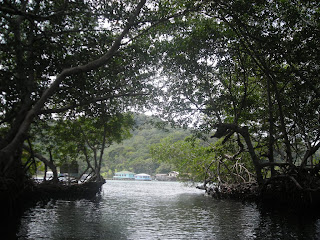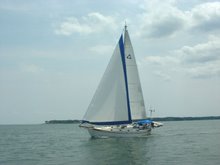Position: N16 23.240 W086 22.568
All over the world people overcome obstacles, annoyances and inconveniences in their lives on a daily basis.
Here in the Bay Islands each island is largely surrounded by barrier reef. These calm the ocean waves before they hit land and therefore provide a safer place to build communities. The islands are covered in high hills covered with rain forest so transportation from one community to the next, before roads were built, was by water. The problem was that to travel from one bay to the next you had to go outside the reef into the ocean and sometimes big seas.
 Calabash Bight Canal Calabash Bight Canal |
 The canal at Jonesville The canal at Jonesville |
 Oak Ridge Canal. These names are not sounding very Central American are they? Remember the British owned this part of the world for a while. Oak Ridge Canal. These names are not sounding very Central American are they? Remember the British owned this part of the world for a while. |
Solution!! Cut through the coral and mangroves inside the reefs to make canals from one community to the next.
Result – delightful passages through mangrove swamps which create a canopy overhead to provide some shade. On the south side of Roatan you can travel between several bays and about 10 miles without even going out into the ocean. On Guanaja you can travel through the middle of the island from the town of Bonacca to the less populated western side.
Then there are the dories.
 |
In Honduras, a dory is a double ended boat usually ranging from about 15-25' in length with a very narrow beam. Based on dug out canoes, the newer ones are made from wooden planks or fiberglass.
 old dugout canoes ("cayucos") still in use in the Bay Islands old dugout canoes ("cayucos") still in use in the Bay Islands |
They have an external rudder which is steered using two pieces of line. The driver sits in the aft end of the boat and pulls one string or the other, depending on which way he wants to turn. Most are powered by a single cylinder gasoline engine, though some have modern high-power diesel engines. The gasoline ones don't seem to have a transmission. If the engine is on, the propeller is turning. Imagine starting your car and it immediately takes off in gear. You have no brakes, so you have to anticipate way ahead of time and turn off the engine to coast to a stop at exactly the right place. This of course takes lots of practice. It is also necessary to not pull in front of one of them when they are clipping along because they cannot stop - they will just run into you! The good part is that, since the un-muffled engines in most of the older dories make a putt putt putt sound, so you can always hear them coming.
 The Lady Nell The Lady Nell |
All of the communities here are on the water and most people do not have land based transportation . Most of them either have some kind of boat, or they ride on water taxis. In the morning you'll see a dory full of kids in their school uniforms being dropped off at school. You'll see older ladies with their umbrellas, for shade, going to church or the store. All the stores have dinghy docks and some communities don't even have roads - they are completely water access only. We have really enjoyed exploring the canals and wandering though the communities by both dinghy and foot. Everyone is so friendly and will wave and shout hello.
 Mark relaxing in Bonocca on an old cayuco converted to a swing Mark relaxing in Bonocca on an old cayuco converted to a swing |
PS – it's really May 18th and we wanted to let you all know we're safe and sound in Guatemala, tied to a dock on the Rio Dulce for the next several months. We'll get caught back up with the Khronicles over the next few weeks.






